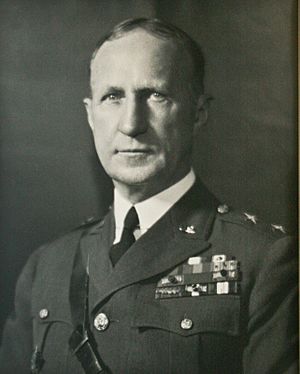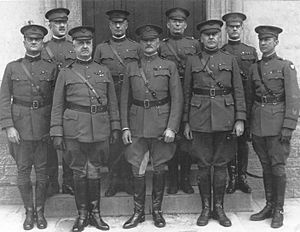George Van Horn Moseley facts for kids
Quick facts for kids
George Van Horn Moseley
|
|
|---|---|

Major General George Van Horn Moseley
|
|
| Born | September 28, 1874 Evanston, Illinois |
| Died | November 7, 1960 (aged 86) Atlanta, Georgia |
| Buried |
West Point Cemetery
|
| Allegiance | United States |
| Service/ |
United States Army |
| Years of service | 1899–1938 |
| Rank | Major General |
| Service number | 0-772 |
| Commands held | Third United States Army 4th Corps Area 5th Corps Area Deputy Chief of Staff of the United States Army 1st Cavalry Division |
| Battles/wars | Spanish–American War Pancho Villa Expedition World War I |
| Awards | Army Distinguished Service Medal (2) Commander of the Legion of Honor (France) Croix de guerre (France) Companion of the Order of the Bath (United Kingdom) Commander of the Order of the Crown (Belgium) Commander of the Order of the Crown of Italy |
George Van Horn Moseley (September 28, 1874 – November 7, 1960) was a high-ranking general in the United States Army. After he retired in 1938, he became known for expressing strong and controversial opinions.
Contents
Early Life and Military Career
George Van Horn Moseley was born in Evanston, Illinois, on September 28, 1874. He attended the United States Military Academy at West Point. He graduated in 1899 and became a second lieutenant in the cavalry.
Service in the Philippines
Moseley served in the Philippines twice. His first tour was from 1900 to 1903. He returned for a second time from 1906 to 1907. During this time, he commanded a troop of the 1st Cavalry. He also worked as an aide to Generals J. M. Bell and J. M. Lee.
In 1901, Moseley, with another officer, bravely entered a Philippine rebel stronghold. They convinced Brigadier General Ludovico Arejola to sign a peace agreement. This happened in Taban, Minalabac, Philippines, on March 25, 1901.
Further Military Education
Moseley was a top student at the Army School of the Line in 1908. He also graduated from the Army Staff College in 1909. In 1911, he completed his studies at the Army War College. These schools helped him prepare for important leadership roles.
World War I Service

During World War I, Moseley served as an assistant chief of staff. He was in charge of logistics for the American Expeditionary Force. This meant he helped manage supplies and movements for American troops overseas.

Post-War Assignments
From 1920 to 1929, Moseley held various assignments. He worked at military camps and in Washington, D.C. He was part of several important groups. One of these was the Harbord Commission. This group looked into issues in Armenia.
In 1921, he helped organize the new Bureau of the Budget. Later that year, he was promoted to brigadier general. From 1927 to 1929, he commanded the 1st Cavalry Division. During this time, he helped stop dangerous stray gunfire. This gunfire came from a Mexican uprising and threatened people in El Paso, Texas. In 1931, he was promoted to major general.
Senior Leadership Roles
Moseley held several important leadership positions. From 1929 to 1930, he was the executive for the Assistant Secretary of War. He then served as the Deputy Chief of Staff of the Army from 1930 to 1933.
Bonus March Incident
In 1932, Moseley was General Douglas MacArthur's Deputy Chief of Staff. This was during the Bonus March on Washington, D.C. During this event, many World War I veterans marched to demand early payment of bonuses. Moseley expressed concerns about certain groups and their influence.
Commanding General Positions
Moseley continued to serve in high command roles. He was the commanding general of the 5th Corps Area from 1933 to 1934. He then led the 4th Corps Area from 1934 to 1936. His final assignment was as commander of the Third United States Army from 1936 to 1938.
Retirement and Later Views
Moseley retired from the Army in October 1938. After his retirement, he became known for expressing very strong and often controversial views. He criticized government policies and expressed opinions that were seen as prejudiced.
For example, he spoke out against President Franklin D. Roosevelt's administration. He also made statements that were considered anti-immigrant and anti-Jewish. These views caused a lot of controversy. The Secretary of War, Harry Hines Woodring, called some of Moseley's statements "flagrantly disloyal."
In 1939, Moseley testified before the House Un-American Activities Committee. He continued to express his controversial beliefs. His statements were so extreme that some were removed from the public record.
Moseley continued to hold these views throughout his life. He believed that certain groups were a threat to the United States. He even suggested that some European groups were "receiving their just punishment."
In 1941, after the attack on Pearl Harbor, Moseley wrote to former president Herbert Hoover. He claimed that a conspiracy involving the British government and certain groups in the United States had pushed Japan to attack.
Later Life and Legacy
In the 1950s, Moseley criticized the Eisenhower Administration. He also supported the rehabilitation of a convicted Nazi war criminal, Karl Doenitz.
In 1951, Moseley was invited to speak at Piedmont College in Georgia. This caused protests from students and faculty due to his views. The college faced significant turmoil, with many faculty and trustees resigning.
In 1959, Moseley helped found Americans for Constitutional Action. This group was seen as a successor to the America First movement.
Moseley died in Atlanta, Georgia, on November 7, 1960, from a heart attack. He was buried at West Point Cemetery. Even after his death, his extreme views continued to influence some military officers.
Awards and Recognition
Moseley received several awards for his military service:
- Army Distinguished Service Medal (with one oak leaf cluster)
- Commander of the Order of the Crown (Belgium)
- Companion of the Order of the Bath (United Kingdom)
- Commander of the Legion of Honor (France)
- Croix de Guerre with Palm (France)
- Commander of the Order of the Crown of Italy
He also received several campaign medals:
- Philippine Campaign Medal
- Mexican Service Medal
- World War I Victory Medal
Family Life
Moseley had three sons. He married Alice Dodds in 1902. After her passing, he married Florence DuBois in July 1930. Alice was the mother of George Jr. and Francis, while Florence was the mother of James.
- Colonel George Van Horn Moseley Jr. led the 502d Parachute Infantry Regiment during the D-Day invasion in Normandy in 1944.
- Francis L. Moseley was an inventor and a Vice President at the Hewlett-Packard Company.
- James W. Moseley was a well-known figure in the UFO enthusiast community.
|


